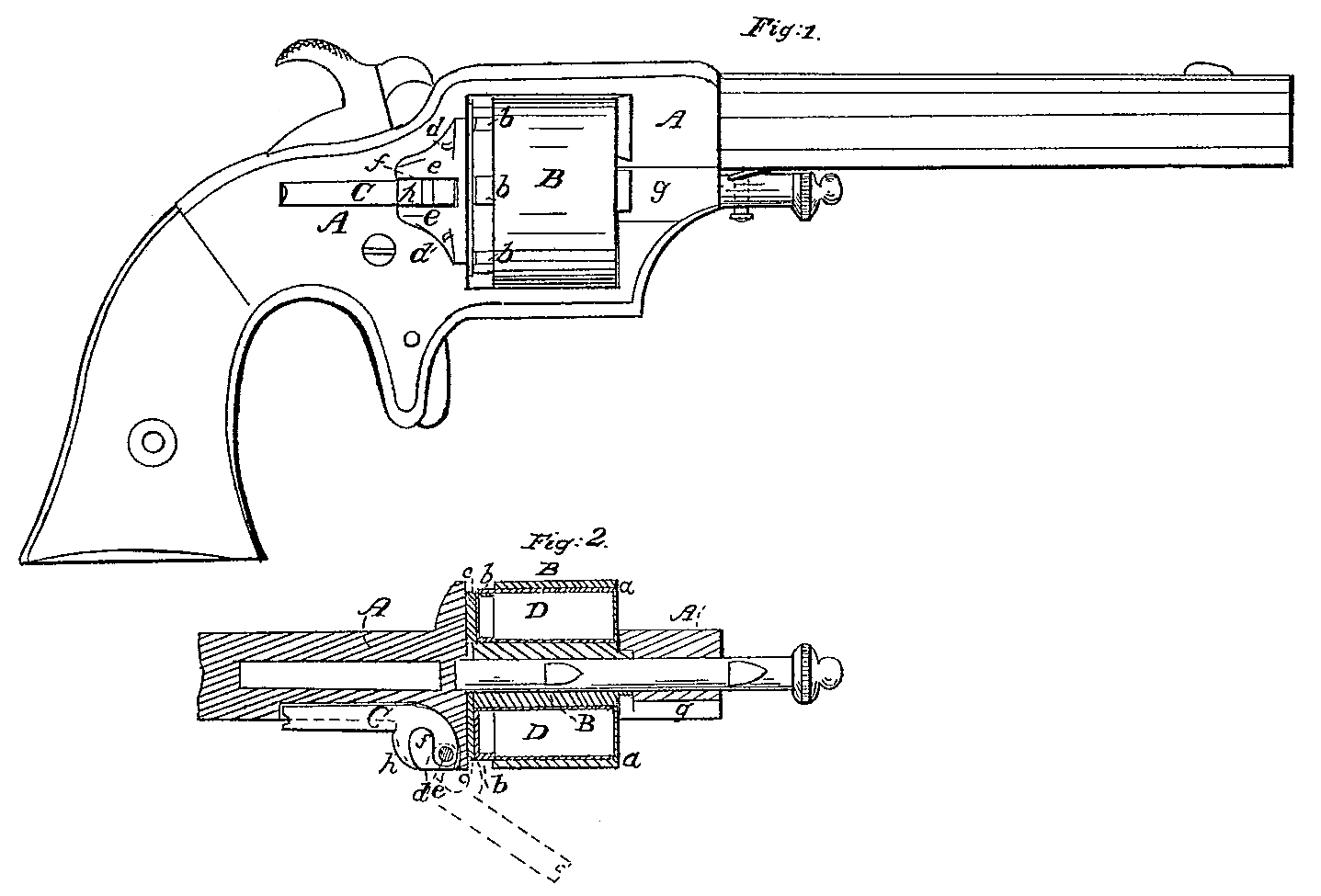US 45176
UNITED STATES PATENT OFFICE.
HENRY REYNOLDS, OF SPRINGFIELD, MASSACHUSETTS.
IMPROVEMENT IN REVOLVING FIRE-ARMS.
Specification forming part of Letters Patent No. 45,176, dated November 22, 1864.
To all whom it may concern:
Be it known that I, Henry Reynolds, of Springfield, in the county of Hampden and State of Massachusetts, have invented a new and Improved Cartridge-Shell Ejector for Fire-Arms; and I do hereby declare that the following is a full, clear, and exact description of the same, reference being had to the accompanying drawings, forming a part of this specification, in which—
Figure 1 is a side view of a revolving pistol having my invention applied. Fig. 2 is a horizontal section of the same.
Similar letters of reference indicate corresponding parts in the several figures.
My invention is designed more especially for application to revolvers which are loaded in front of the chambers with metallic cartridges, but is also applicable to some kinds of breech-loading fire-arms, which are similarly loaded.
It consists of a lever attached by a fulcrum pin to the exterior of the fire-arm in rear of the chamber or chambers and having attached to it a wedge, which, by moving the lever forward, is made to enter an opening in the chamber or chambers and between the breech and the rear end of the cartridge-shell, and so push forward the shell.
I will proceed to describe the application of my invention to the revolver, which will enable others skilled in the art to apply it also to breech-loading fire-arms, as the manner of its application to the latter will be essentially the same.
A is the frame of the arm. B is the cylinder, constructed solid, or with shoulders for the support of the rear ends of the cartridges, at the rear of the chambers at a, and with openings b b in the sides, which permit the hammer to strike upon the cartridges and also provide for the entrance of the wedge of the ejector, the said openings extending backward to the rears of the chambers and being beveled, as shown at c c in Fig. 2, for the entrance of the wedge between the rear ends of the cartridge shells D D and the rears of the chambers.
C is the cartridge-shell ejector, consisting of a curved lever, which is secured by its fulcrum pin d in a mortise, f, in the side of the frame, behind the cylinder. The frame is made with a protuberance, e, for the reception of the fulcrum end of the lever, the said protuberance having a part of the mortise f within it and being formed to receive the wedge h, which is formed of the same piece with the lever, when the latter is thrown back, as shown in Fig. 1, and in black outline in Fig. 2, as it always is when not in use.
When it is desired to eject the exploded cartridge-shells the hammer is brought to half-cock to permit the cylinder to be turned by hand, and the cylinder is then turned to bring one of the chambers a, a opposite to the groove g, which is provided in the front part of the frame A, on the same side as the ejector, the said chamber being then also opposite or in line with the ejector. The ejector is then moved forward to the position shown in red outline, by which means the point or sharp edge of its wedge is caused to enter the hole b between the cartridge-shell and the rear end or shoulder of the chamber, and thereby start the cartridge-shell forward. If the chambers and cartridge-shells are made slightly tapering, a sudden forward movement of the ejector will throw the shell completely out of the chamber, other wise, after being started forward, the shell may be pulled out by taking hold of its front end with the thumb and finger. When one shell has been ejected or taken out the lever is moved back a little way and the cylinder turned to bring another chamber opposite to or in line with it, and the operation is repeated. The several chambers are brought one after another to the above-mentioned position and the operation of the ejector each time repeated until all the shells have been extracted. The ejector may be used in the same way to unload the pistol or any of the chambers which have not been fired.
What I claim as my invention, and desire to secure by Letters Patent, is—
The ejector consisting of a lever, C, and attached Wedge h, applied to the exterior of the frame of a fire arm, and in combination with its chamber or chambers, and operating substantially as herein specified.
HENRY REYNOLOS.
Witnesses:
Saml. Griswold,
A. P. Casey.

